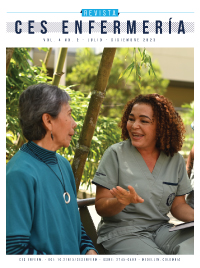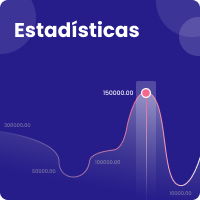Prone position in patients admitted to the Intensive Care Unit with a diagnosis of COVID-19
DOI:
https://doi.org/10.21615/cesenferm.7316Keywords:
COVID 19, SARS-CoV-2 Infection, PronationAbstract
Objective: To characterize prone position therapy and its main complications in patients admitted to an Intensive Care Unit with a diagnosis of COVID-19. Method: a cross-sectional observational study. Based on clinical records of 386 patients diagnosed with COVID-19 admitted to an Intensive Care Unit (ICU) of the third level of complexity in March 2020-March 2021. Clinical characteristics on admission to the ICU, variables related to pronation, complications in pronated patients. Research approved by the ethics committee. Results: Most of the patients admitted to the ICU for COVID-19 were men, with an average age of 61 years and an average weight of 77 kg. Almost half were admitted with high blood pressure. The average value of respiratory rate was 24 per minute and oximetry 92.8%. 58% received prone position therapy. The maximum number of cycles was 14, with an average duration of 21 hours. 60.6% presented one or more complications after pronation. Conclusion: Pronation is an intervention that improves oxygenation indices in patients with respiratory failure due to COVID-19 or another etiology. Despite its benefits, it is not without risks, among which the high prevalence of skin lesions stands out. This may be influenced by the context of the pandemic, which leads to a more significant burden on health systems and permeates the provision of health services.
Downloads
References
Zhang J, Cao Y, Tan G, Dong X, Wang B, Lin J, et al. Clinical, radiological, and laboratory characteristics and risk factors for severity and mortality of 289 hospitalized COVID‐19 patients. Allergy [Internet]. 2021 Feb 24;76(2):533–50. Available from: https://onlinelibrary.wiley.com/doi/10.1111/all.14496
Elharrar X, Trigui Y, Dols A-M, Touchon F, Martinez S, Prud’homme E, et al. Use of Prone Positioning in Nonintubated Patients With COVID-19 and Hypoxemic Acute Respiratory Failure. JAMA [Internet]. 2020 Jun 9;323(22):2336. Available from: https://jamanetwork.com/journals/jama/fullarticle/2766292
Cornejo RA, Díaz JC, Tobar EA, Bruhn AR, Ramos CA, González RA, et al. Effects of prone positioning on lung protection in patients with acute respiratory distress syndrome. Am J Respir Crit Care Med [Internet]. 2013 Aug 15;188(4):440–8. Available from: http://www.ncbi.nlm.nih.gov/pubmed/23348974
Ibarra G, Rivera A, Fernandez-Ibarburu B, Lorca-García C, Garcia-Ruano A. Prone position pressure sores in the COVID-19 pandemic: The Madrid experience. J Plast Reconstr Aesthetic Surg [Internet]. 2021 Sep;74(9):2141–8. Available from: https://linkinghub.elsevier.com/retrieve/pii/S1748681520307324
Guérin C, Reignier J, Richard J-C, Beuret P, Gacouin A, Boulain T, et al. Prone Positioning in Severe Acute Respiratory Distress Syndrome. N Engl J Med [Internet]. 2013 Jun 6;368(23):2159–68. Available from: http://www.nejm.org/doi/10.1056/NEJMoa1214103
Colombia. Ministerio de Salud y la Protección Social. Resolución 8430. Por la cual se establecen las normas científicas, técnicas y administrativas para la investigación en salud. 1993.
Liu X, Liu H, Lan Q, Zheng X, Duan J, Zeng F. Early prone positioning therapy for patients with mild COVID-19 disease. Med Clin (Barc) [Internet]. 2021 Apr;156(8):386–9. Available from: https://linkinghub.elsevier.com/retrieve/pii/S0025775320308848
Gattinoni L, Tognoni G, Pesenti A, Taccone P, Mascheroni D, Labarta V, et al. Effect of Prone Positioning on the Survival of Patients with Acute Respiratory Failure. N Engl J Med [Internet]. 2001 Aug 23;345(8):568–73. Available from: http://www.nejm.org/doi/abs/10.1056/NEJMoa010043
Guerin C, Gaillard S, Lemasson S, Ayzac L, Girard R, Beuret P, et al. Effects of Systematic Prone Positioning in Hypoxemic Acute Respiratory Failure. JAMA [Internet]. 2004 Nov 17;292(19):2379. Available from: http://jama.jamanetwork.com/article.aspx?doi=10.1001/jama.292.19.2379
Mancebo J, Fernández R, Blanch L, Rialp G, Gordo F, Ferrer M, et al. A Multicenter Trial of Prolonged Prone Ventilation in Severe Acute Respiratory Distress Syndrome. Am J Respir Crit Care Med [Internet]. 2006 Jun;173(11):1233–9. Available from: http://www.atsjournals.org/doi/abs/10.1164/rccm.200503-353OC
World Health Organization. World Health Organization. Clinical management of severe acute respiratory infection (SARI) when COVID-19 disease is suspected. Interim guidance [Internet]. 2020 [cited 2022 Feb 3]. Available from: https://www.who.int/docs/default-source/coronaviruse/clinical-management-of-novel-cov.pdf
Alhazzani W, Møller MH, Arabi YM, Loeb M, Gong MN, Fan E, et al. Surviving Sepsis Campaign: guidelines on the management of critically ill adults with Coronavirus Disease 2019 (COVID-19). Intensive Care Med [Internet]. 2020 May 28;46(5):854–87. Available from: http://link.springer.com/10.1007/s00134-020-06022-5
Sorbello M, El‐Boghdadly K, Di Giacinto I, Cataldo R, Esposito C, Falcetta S, et al. The Italian coronavirus disease 2019 outbreak: recommendations from clinical practice. Anaesthesia [Internet]. 2020 Jun 30;75(6):724–32. Available from: https://onlinelibrary.wiley.com/doi/10.1111/anae.15049
Bellani G, Laffey JG, Pham T, Fan E, Brochard L, Esteban A, et al. Epidemiology, Patterns of Care, and Mortality for Patients With Acute Respiratory Distress Syndrome in Intensive Care Units in 50 Countries. JAMA [Internet]. 2016 Feb 23;315(8):788. Available from: http://jama.jamanetwork.com/article.aspx?doi=10.1001/jama.2016.0291
Bellani G, Grasselli G, Cecconi M, Antolini L, Borelli M, De Giacomi F, et al. Noninvasive Ventilatory Support of Patients with COVID-19 outside the Intensive Care Units (WARd-COVID). Ann Am Thorac Soc [Internet]. 2021 Jun;18(6):1020–6. Available from: https://www.atsjournals.org/doi/10.1513/AnnalsATS.202008-1080OC
Cummings MJ, Baldwin MR, Abrams D, Jacobson SD, Meyer BJ, Balough EM, et al. Epidemiology, clinical course, and outcomes of critically ill adults with COVID-19 in New York City: a prospective cohort study. Lancet [Internet]. 2020 Jun;395(10239):1763–70. Available from: https://linkinghub.elsevier.com/retrieve/pii/S0140673620311892
Mittermaier M, Pickerodt P, Kurth F, de Jarcy LB, Uhrig A, Garcia C, et al. Evaluation of PEEP and prone positioning in early COVID-19 ARDS. EClinicalMedicine [Internet]. 2020 Nov;28:100579. Available from: https://linkinghub.elsevier.com/retrieve/pii/S2589537020303230
Munshi L, Del Sorbo L, Adhikari NKJ, Hodgson CL, Wunsch H, Meade MO, et al. Prone Position for Acute Respiratory Distress Syndrome. A Systematic Review and Meta-Analysis. Ann Am Thorac Soc [Internet]. 2017 Oct;14(Supplement_4):S280–8. Available from: https://www.atsjournals.org/doi/10.1513/AnnalsATS.201704-343OT
Chua EX, Zahir SMISM, Ng KT, Teoh WY, Hasan MS, Ruslan SRB, et al. Effect of prone versus supine position in COVID-19 patients: A systematic review and meta-analysis. J Clin Anesth [Internet]. 2021 Nov;74:110406. Available from: https://linkinghub.elsevier.com/retrieve/pii/S0952818021002464
Girard R, Baboi L, Ayzac L, Richard J-C, Guérin C. The impact of patient positioning on pressure ulcers in patients with severe ARDS: results from a multicentre randomised controlled trial on prone positioning. Intensive Care Med [Internet]. 2014 Mar 19;40(3):397–403. Available from: http://link.springer.com/10.1007/s00134-013-3188-1
Sud S, Friedrich JO, Adhikari NKJ, Taccone P, Mancebo J, Polli F, et al. Effect of prone positioning during mechanical ventilation on mortality among patients with acute respiratory distress syndrome: a systematic review and meta-analysis. Can Med Assoc J [Internet]. 2014 Jul 8;186(10):E381–90. Available from: http://www.cmaj.ca/lookup/doi/10.1503/cmaj.140081
Lucchini A, Bambi S, Mattiussi E, Elli S, Villa L, Bondi H, et al. Prone Position in Acute Respiratory Distress Syndrome Patients. Dimens Crit Care Nurs [Internet]. 2020;39(1):39–46. Available from: http://journals.lww.com/00003465-202001000-00006
Taylor M, Kepner S, Gardner LA, Jones R. Patient Safety Concerns in COVID-19–Related Events: A Study of 343 Event Reports From 71 Hospitals in Pennsylvania. Patient Saf [Internet]. 2020 Jun 17;16–27. Available from: https://patientsafetyj.com/index.php/patientsaf/article/view/patient-safety-concerns-covid19
King R, Ryan T, Senek M, Wood E, Taylor B, Tod A, et al. The impact of COVID‐19 on work, training and well‐being experiences of nursing associates in England: A cross‐sectional survey. Nurs Open [Internet]. 2022 May 10;9(3):1822–31. Available from: https://onlinelibrary.wiley.com/doi/10.1002/nop2.928
Taccone P, Pesenti A, Latini R, Polli F, Vagginelli F, Mietto C, et al. Prone Positioning in Patients With Moderate and Severe Acute Respiratory Distress Syndrome. JAMA [Internet]. 2009 Nov 11;302(18):1977. Available from: http://jama.jamanetwork.com/article.aspx?doi=10.1001/jama.2009.1614
Downloads
Published
How to Cite
Issue
Section
License
Copyright (c) 2023 CES Enfermería

This work is licensed under a Creative Commons Attribution-NonCommercial-ShareAlike 4.0 International License.
| Article metrics | |
|---|---|
| Abstract views | |
| Galley vies | |
| PDF Views | |
| HTML views | |
| Other views | |




